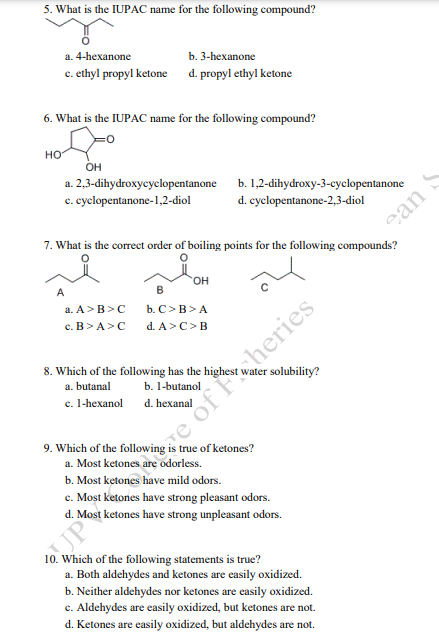Organic Chemistry: A Guided Inquiry
2nd Edition
ISBN:9780618974122
Author:Andrei Straumanis
Publisher:Andrei Straumanis
Chapter13: Substitution
Section: Chapter Questions
Problem 2E
Related questions
Question

Transcribed Image Text:5. What is the IUPAC name for the following compound?
a. 4-hexanone
b. 3-hexanone
c. ethyl propyl ketone d. propyl ethyl ketone
6. What is the IUPAC name for the following compound?
HO
OH
a. 2,3-dihydroxycyclopentanone
b. 1,2-dihydroxy-3-cyclopentanone
c. cyclopentanone-1,2-diol
7. What is the correct order of boiling points for the following compounds?
ean
d. cyclopentanone-2,3-diol
HO.
A
B
a. A>B>C
b. C>B>A
с. В> A>С
d. A>C>B
8. Which of the following has the highest water solubility?
a. butanal
ь. 1-butanol
c. I-hexanol d. hexanal
9. Which of the following is true of ketones?
a. Most ketones are odorless.
b. Most ketones have mild odors.
c. Most ketones have strong pleasant odors.
d. Most ketones have strong unpleasant odors.
JPW Te orheries
10. Which of the following statements is true?
a. Both aldehydes and ketones are easily oxidized.
b. Neither aldehydes nor ketones are easily oxidized.
c. Aldehydes are easily oxidized, but ketones are not.
d. Ketones are easily oxidized, but aldehydes are not.
Expert Solution
This question has been solved!
Explore an expertly crafted, step-by-step solution for a thorough understanding of key concepts.
This is a popular solution!
Trending now
This is a popular solution!
Step by step
Solved in 3 steps with 1 images

Knowledge Booster
Learn more about
Need a deep-dive on the concept behind this application? Look no further. Learn more about this topic, chemistry and related others by exploring similar questions and additional content below.Recommended textbooks for you

Organic Chemistry: A Guided Inquiry
Chemistry
ISBN:
9780618974122
Author:
Andrei Straumanis
Publisher:
Cengage Learning

Introductory Chemistry: A Foundation
Chemistry
ISBN:
9781337399425
Author:
Steven S. Zumdahl, Donald J. DeCoste
Publisher:
Cengage Learning

Introduction to General, Organic and Biochemistry
Chemistry
ISBN:
9781285869759
Author:
Frederick A. Bettelheim, William H. Brown, Mary K. Campbell, Shawn O. Farrell, Omar Torres
Publisher:
Cengage Learning

Organic Chemistry: A Guided Inquiry
Chemistry
ISBN:
9780618974122
Author:
Andrei Straumanis
Publisher:
Cengage Learning

Introductory Chemistry: A Foundation
Chemistry
ISBN:
9781337399425
Author:
Steven S. Zumdahl, Donald J. DeCoste
Publisher:
Cengage Learning

Introduction to General, Organic and Biochemistry
Chemistry
ISBN:
9781285869759
Author:
Frederick A. Bettelheim, William H. Brown, Mary K. Campbell, Shawn O. Farrell, Omar Torres
Publisher:
Cengage Learning